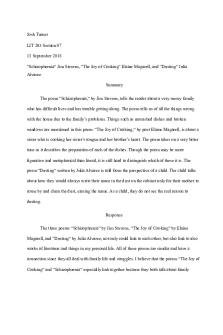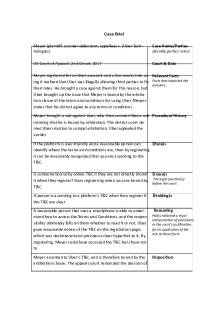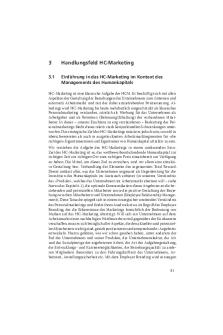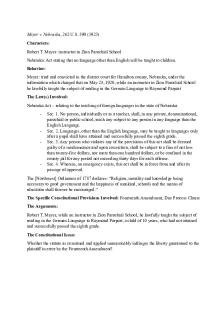Meyer 1 - Review PDF

| Title | Meyer 1 - Review |
|---|---|
| Course | BS Physical Therapy |
| Institution | University of Perpetual Help System Jonelta |
| Pages | 43 |
| File Size | 391.2 KB |
| File Type | |
| Total Downloads | 308 |
| Total Views | 501 |
Summary
You are evaluating a 26 year-old male patient status post arthroscopic surgery. The physician requests that you may evaluate the muscles that insert into the pes anserinus. You may have the patients flex the knee medially rotate the leg while the knee is flexed. Of the muscles listed below, which ar...
Description
Practice Questions
1
1.
You are evaluating a 26 year-old male patient status post arthroscopic surgery. The physician requests that you may evaluate the muscles that insert into the pes anserinus. You may have the patients flex the knee medially rotate the leg while the knee is flexed. Of the muscles listed below, which are you not evaluating? A. Gracilis B. Sartorius C. Semimembranosus D. Semitendinosus
2.
You are treating a patient secondary to a foot injury. The patient reports that his podiatrist thought the spring ligament was injured as a result of his fall. Which of the following best describes the spring ligament of foot? A. It is also called the plantar calcaneocuboid ligament B. It is called the short plantar ligament C. It helps to maintain the medial arch of the foot by supporting the head of the talus. D. The spring ligament is not highly elastic
3.
The patient who has a lesion of the inferior gluteal nerve is referred to the clinic. Which of the following motions would most likely be affected to the greatest extent secondary to an inferior gluteal nerve lesion? A. Hip abduction B. Hip adduction C. Hip flexion D. Hip extension
4.
The physician has sent a patient to the clinic for a brace that will assist in controlling knee rotation and adduction. Which of the following ligaments was not likely injured? A. Anterior cruciate ligament B. Posterior cruciate ligament C. Medial collateral ligament D. Lateral collateral ligament
5.
When performing ultrasound on a patient, it is important to be aware of the contraindications for its utilization. One contraindication is performing ultrasound over the epiphyseal or growth plate of a child. Which of the following statements is not true concerning the growth plate? A. It serves as a site of progressive lengthening that is needed in the long bones B. It lies between the epiphysis and diaphysis as a transverse disc C. It is formed of cartilage D. It is found in all bones
6.
Bursae may be found in most locations within the body. In which of the following anatomical areas would the bursae most likely not be found? A. Subtendinous B. Intramuscular C. Subcutaneous D. Subfascial
7.
In a class on clinical pathology, the professor asks you what lupus erythematosus; scleroderma and dermatomycosis have in common. They can best be grouped together as which of the following? A. Acute infection B. Acute bacterial diseases C. Collagen vascular diseases D. Circulatory disorder
8.
In clinical pathology class, the professor describes a pathological disease that involves the arteries and veins of the lower extremity. The symptoms are inflammation, venous thrombosis, and ischemia of the feet. Which of the following diseases is being described by the professor? A. Raynaud's disease B. Thromboangiitis obliterans C. Thrombophlebitis D. Pitting edema
2ca5c0fb06e0dcc11e773275bc895b1f.doc
2
Practice Questions
9.
You are treating a patient who is complaining of right shoulder pain. The patient has been diagnosed with frozen shoulder. Which of the following would describe the capsular pattern of the glenohumeral joint? A. External rotation, abduction, internal rotation B. External rotation, internal rotation, abduction C. Internal rotation, abduction, external rotation D. Abduction, external rotation, internal rotation
10.
A patient is sent to physical therapy secondary to a lower extremity injury. Reading the patient’s past medical history, you note that the superficial peroneal nerve has been severed. Which of the following muscles would be emphasized in your treatment program. A. Tibialis anterior B. Peroneus tertius C. Peroneus brevis D. Extensor hallucis longus
11.
You are in a cardiology class studying the difference between cardiac muscle versus skeletal muscle. It is known that the cardiac muscle is physiologically different from skeletal muscle. Which of the following statement best describe this? A. It has no bony attachment B. The actin and myosin filaments produce a different type of striation C. It does not develop a length-tension relationship D. It divides into atrial and ventricular portions.
12.
While studying cardiology you are learning about cardiac output. Cardiac output refers to the amount of blood pumped by the heart in a specific time period. Which of the following best describes cardiac output? A. Blood pumped by the heart in a 24 hour period B. Blood pumped by the heart in 1 hour C. Blood pumped by the heart during a 60 second period D. Blood pumped by the heart during an 8-hour period.
13.
You are working with a patient who has small stroke volume and pulse pressure. Which of the following lesions does the patient most likely have? A. Arterial sclerotic disease B. Mitral stenosis C. Congestive heart failure D. Myocardial infarction
14.
Which of the following is the most frequent location for a myocardial infarction to occur? A. Left atrium B. Left ventricle C. Right atrium D. Right ventricle
15.
Which of the following is the most common cause of CVA (cerebrovascular accident) in older adults? A. Aneurysm B. Hemorrhaging C. High blood pressure D. Thrombosis
16.
Which of the following actions of the drug digitalis is common in a patient with chronic congestive heart failure? A. A decrease in heart rate B. An increase in heart rate C. A decrease in the strength of the contraction D. No effect on heart rate
2ca5c0fb06e0dcc11e773275bc895b1f.doc
Practice Questions
3
17.
You are physical therapist at the site of the football game as a medical staff member. You watch one of the players fall from blow to the head and determined by a field evaluation that he has suffered a concussion. Which of the following best defined as a concussion? A. Any severe blow to the head B. A fracture of the skull C. Swelling of the brain as a result of trauma D. A temporary state of the paralysis of the nervous function, including loss of consciousness
18.
Rheumatoid arthritis can cause many symptoms in its later stages. Which of the following symptoms would most likely be common in patients who has had rheumatoid arthritis for a long period of time? A. Radial deviation of the finger B. Enlargement of the Heberden’s nodes C. Ulnar deviation of the finger D. Increase muscle strength
19.
You are studying the various types of arthritis, especially rheumatoid arthritis versus osteoarthritis. Which of the following would best describe the etiology of osteoarthritis? A. Trauma to a joint recently B. Under weight C. Degeneration caused by aging D. Recent injury to the joint.
20.
Which of the following definitions best describes the anatomical dead space? A. The portion of the pulmonary tree that is inelastic and does not change size with inspiration or expiration B. An area occupied in the airways that does not permit gas exchange C. The pulmonary air with the least blood supply D. The portion of the pulmonary tree that is not supplied with sensory nerves
21.
You are in physiology class studying tissue excitation. In regard to the strength/duration curve, which of the following is not a true statement? A. It may be considered valuable in testing for nerve degeneration B. It may be considered valuable in testing for nerve regeneration C. It shows the relationship of a current intensity to the duration of the reaching expectation threshold D. It exhibits development and fatigue during a prolonged stimulation
22.
In a class on physiology of exercise, you are studying the energy needed for muscle contractions. Which of the following statements is false in regard to energy for muscle contractions? A. Energy is produced during aerobic metabolism B. Energy is produced during anaerobic metabolism C. Energy may be stored as a creatine phosphate D. Energy is derived from ATP (adenosine triphosphate)
23.
You are studying diabetes mellitus and diabetes insipidus in your clinical pathology course. Which of the following statement is not true about diabetes mellitus, but best describes diabetes insipidus? A. Is a disorder of carbohydrate metabolism B. It results from insulin deficiency C. It is associated with the pancreas D. It is associated with the pituitary gland
24.
Which of the following gestational timeframes is the most susceptible for injury to the fetal cardiovascular system? It is during this timeframe that the fetal cardiovascular system produces most congenital defects. A. Third month B. Sixth month C. Between the 21st and 40th days D. Conception and the 20th day
2ca5c0fb06e0dcc11e773275bc895b1f.doc
4
Practice Questions
25.
A patient comes to the clinic with an injury to the skin as a result of exposure to excessive heat. Which of the following listed below will be the first response to this type of skin injury? A. The fluids will seep into the damaged tissue B. The blood vessels will become dilated and more permeable secondary to inflammation C. Phagocytic cells will remove dead cells and debridement of the area will occur D. Blood clotting will occur
26.
The professor is presenting a lecture on the advantages and disadvantages of the following exercises: Isometric, isokinetic, isotonic, and eccentric contractions. The professor informs the class that some of the disadvantages of a particular exercise are that it loads muscle at the weakest point and the momentum factor in lifting. These disadvantages best describe which of the following classifications of exercise? A. Isometric B. Isotonic C. Isokinetic D. Free weights
27.
The patient has experienced a lesion in the frontal lobe of the cerebral hemisphere. Which of the following would most likely be affected? A. Vision B. Sensory perception and interpretation C. Personality and speech D. Hearing and comprehension of speech
28.
A patient experiences an injury resulting in a lesion of the occipital lobe of the cerebral hemisphere. Which of the following are most likely involved? A. Vision and interpretation of visual data B. Sensory perception and interpretation C. Intelligence and personality D. Comprehension of speech and memory
29.
An 18-year-old male tests positive for shoulder dislocation. This patient may have complications as a result of this shoulder dislocation. Which of the following would most likely be involved if the patient were to have complications? A. Axillary artery B. Axillary nerve C. Radial artery D. Radial nerve
30.
In studying physical therapy you are learning about the differences between various spina bifida disorders. You are specifically studying spina bifida myelocele. Which of the following would best describe this disorder? A. A soft tissue tumor in the meninges B. A soft tissue tumor in the spinal cord C. The most severe form of spina bifida D. A herniated sac contained within the spinal cord
31.
A patient reports to physical therapy with a diagnosis of a lesion in the lateral cord of the brachial plexus. Which of the following would you most likely detect upon treatment of this patient? A. Paralysis of the biceps, coracobrachialis, and finger flexors B. Paralysis of the deltoid C. Paralysis of wrist extension D. Paralysis of the hand
32.
You are performing physical therapy on a patient status post cerebrovascular accident. The patient is having difficulty with trunk control and transfers from supine to sit and left to right sidelying. In performing PNF techniques on this patient, which of the following would be best to utilize to assist this patient? A. Hold and relax B. Rhythmic initiation C. Rhythmic stabilization D. Slow reversal hold
2ca5c0fb06e0dcc11e773275bc895b1f.doc
Practice Questions
5
33.
In studying the pulmonary system of a patient, you are discussing site of gas exchange in the pulmonary system. Which of the following is the most likely site of gas exchange? A. Alveoli B. Bronchi C. Brachialis D. Trachea
34.
You are performing passive range of motion on a pulmonary patient. What effect will passive range of motion have on this patient’s pulmonary ventilation? A. No effect B. An undetermined effect C. A response proportional to the number of joints involved in passive range of motion D. A response proportional to the speed and duration of exercises administered
35.
You have a patient who has episodes of dyspnea and difficulty in expiration. Which of the following would your patient most likely be experiencing? A. Asthma B. Bronchitis C. Emphysema D. Cystic fibrosis
36.
The client has been positioned on his side. You would anticipate that which of the following areas would be a pressure point in this position? A. Sacrum B. Occiput C. Ankles D. Heels
37.
The patient is a 26-year-old male, status post ankle fracture. The physician orders mobilization to increase joint range of motion. Which of the following is the maximum loose-packed position of the ankle joint? A. 10 plantar flexion B. 5 plantar flexion C. 0 plantar flexion D. 15 plantar flexion
38.
You are treating a patient status post total hip replacement. You notice in the patient’s chart that the patient has received a cemented total hip replacement. Which of the following is not an advantage of a cemented hip? A. It allows early weight bearing B. Surgeons report a 90% success rate C. There is less postoperative pain D. It requires less bone tissue removal
39.
In class you are studying the elbow joint and optimum force output. Which of the following would be the position for elbow flexion in terms of the greatest advantage of optimum force output? A. 120 of elbow flexion B. Flexion supination C. Midposition or semiprone D. 90 of elbow flexion
40.
In anatomy class you are studying the tendinous cuff muscles, also called SITS (supraspinatus, infraspinatus, teres minor). Which of the following does the combined action of the tendinous cuff muscles produce? A. Abduction of the shoulder B. External rotation of the shoulder C. Pulling of the humerus upward and outward D. Depression of the head of the humerus
2ca5c0fb06e0dcc11e773275bc895b1f.doc
6
Practice Questions
41.
Your patient is a 26-year-old paraplegic. You are observing the patient standing with braces for a prolonged time. For the paraplegic, prolonged standing with braces in a lordotic position may result in which of the following? A. Stretching of the hip flexors B. Stretching of the hip extensors C. Stretching of the hip extensors and iliofemoral ligament D. Stretching of the ischial femoral ligament
42.
You are in anatomy class studying motions of the wrist. It is known that the motion that the wrist produces is actually a combination of several motions at several different articulations. Which of the following would best describe the axis of motion for the radial and ulnar deviation? A. It lies in the coronal plane through the lunate B. It lies in the sagittal plane through the trapezoid C. It lies in the sagittal plane through the capitate D. It lies in the coronal plane through the capitate
43.
You are performing a test on a patient for hip flexor length. Upon testing the hip, the extremity being tested abducts and remains slightly flexed when lowered to the table. Which of the following would you most likely suspect of muscle tightness? A. Psoas major B. Tensor fascia latae C. Semitendinosus D. Rectus femoris
44.
On the patient described above, you decide to measure normal expansion at the xiphoid process. Which of the following would be the normal value for expansion when measured at the xiphoid process? A. 5 to 10 cm B. 5 to 10 in C. 5 to 1.0 cm D. 5 to 1.0 in
45.
You are performing a postural examination on a 16-year-old track and field star. Upon posture evaluation you notice that the patient has pronated feet. Which of the following would best describe this condition? A. Lateral convexity of the Achilles’ tendon due to a medial weight line B. Eversion of the calcaneus with lateral convexity of the Achilles’ tendon C. Eversion of the calcaneus with a medial weight line D. Inversion of the calcaneus with a medial weight line
46.
You are in rheumatology class studying degenerative joint disease. The instructor asks you where Heberden's nodes are most frequently located as a result of degenerative joint disease. Which of the following is the correct answer? A. Distal and proximal interphalangeal joints of the fingers B. Distal and proximal interphalangeal joints of the fingers and toes C. Distal interphalangeal joints of the fingers D. Distal interphalangeal joints of the toes
47.
You are performing a gait evaluation on a cross-country track runner who pulled a hamstring muscle. During which period of time in the patient's gait cycle would the hamstring muscle be the most active? A. Midstance to heel-off B. Swing phase C. Acceleration to midswing D. Midswing to deceleration
48.
You are performing palpation on a patient with general lower back pain. Which of the following landmarks would be most helpful to isolate the L4 vertebral level upon palpation of this patient? A. Anterior superior iliac spine B. Posterior superior iliac spine C. Iliac crest D. Greater trochanter
2ca5c0fb06e0dcc11e773275bc895b1f.doc
Practice Questions
7
49.
Your patient is a 56-year-old female with a diagnosis of a herniated disc between vertebrae C6 and C7. During a conversation with the physician, he informs you that the patient has a C7 nerve root impingement. Upon testing this patient, you expect weakness in all of the following motor activities except for which one? A. Wrist flexion B. Finger flexion C. Finger extension D. Elbow extension
50.
You are performing ultrasound underwater to a patient’s left hand. In performing the ultrasound under water which of the following would be the most important safety factor to be considered? A. Utilizing a plastic bucket instead of a metal whirlpool B. Keeping the ultrasound head moving C. Keeping the ultrasound watts per centimeters squared under 1.0 D. Connecting the ultrasound to a ground fault interruption circuit
51.
You have been called into the physical therapy department secondary to a patient being brought into the emergency room with severe burns on both posterior lower extremities. The physician instructs you to begin working with this newly admitted burn patient. Which of the following would be your first priority? A. Performing an evaluation on the wound area B. Splinting to control contractures and edema C. Closing the wound D. Beginning immediate wound cleaning, debridement, and sterile dressing
52.
The physician has instructed you to perform ultrasound under water secondary to a patient experiencing foot pain in the medial arch. When administering ultrasound under water, which of the following would be the best position for the sound head? A. The sound head should be in direct contact with the medial arch of the foot B. The sound head should be approximately 3 inches away from the medial arch of the foot C. The sound head should be approximately 1 inch away from the medial arch of the foot D. The sound head should be approximately 9 cm from the medi...
Similar Free PDFs

Meyer 1 - Review
- 43 Pages

Lezione 1 Meyer
- 7 Pages

Meyer December 4
- 2 Pages

Meyer Sept 13
- 2 Pages

Meyer October 18
- 3 Pages

Meyer v. Uber Technologies
- 2 Pages

Controlando sus Emociones - Joyce Meyer
- 124 Pages

Kap 3 Meyer Ferreira HC-Marketing
- 34 Pages

A Forca da Tradicao - Arno Meyer
- 6 Pages

Lecture #5 (Feb 9) - Oded Meyer
- 18 Pages

Joyce Meyer - Mujer Segura DE SI Misma
- 192 Pages
Popular Institutions
- Tinajero National High School - Annex
- Politeknik Caltex Riau
- Yokohama City University
- SGT University
- University of Al-Qadisiyah
- Divine Word College of Vigan
- Techniek College Rotterdam
- Universidade de Santiago
- Universiti Teknologi MARA Cawangan Johor Kampus Pasir Gudang
- Poltekkes Kemenkes Yogyakarta
- Baguio City National High School
- Colegio san marcos
- preparatoria uno
- Centro de Bachillerato Tecnológico Industrial y de Servicios No. 107
- Dalian Maritime University
- Quang Trung Secondary School
- Colegio Tecnológico en Informática
- Corporación Regional de Educación Superior
- Grupo CEDVA
- Dar Al Uloom University
- Centro de Estudios Preuniversitarios de la Universidad Nacional de Ingeniería
- 上智大学
- Aakash International School, Nuna Majara
- San Felipe Neri Catholic School
- Kang Chiao International School - New Taipei City
- Misamis Occidental National High School
- Institución Educativa Escuela Normal Juan Ladrilleros
- Kolehiyo ng Pantukan
- Batanes State College
- Instituto Continental
- Sekolah Menengah Kejuruan Kesehatan Kaltara (Tarakan)
- Colegio de La Inmaculada Concepcion - Cebu




